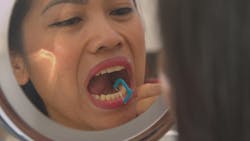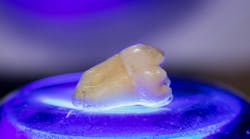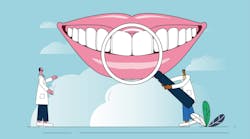Promising study paves the way for future vaccines administered via dental floss
Will annual flu shots become obsolete? Promising results from a recent study published in Nature Biomedical Engineering reveals vaccines may be administered via dental floss in the future. Successful trials on an animal model showed that dental floss can introduce vaccine antibodies through contact with the tissue between the teeth and gums.1
The power of mucosal surfaces
The scientists' novel technique stimulates the production of antibodies in mucosal surfaces, which are typically the conduits pathogens use to enter the body. According to Harvinder Singh Gill, vaccines given by injection primarily produce antibodies in the bloodstream, but when delivered via the mucosal surface, antibodies are produced in both the bloodstream and mucosal surfaces. This second layer of defense helps the body fight off the pathogen and develop a stronger resistance.1
Why dental floss?
The epithelium is the tissue that lines the surface of your body parts-such as the stomach and intestinal lining-but the junctional epithelium refers to the tissue between the tooth and gum. According to Gill, "Because the junctional epithelium is more permeable than other epithelial tissues - and is a mucosal layer - it presents a unique opportunity for introducing vaccines to the body in a way that will stimulate enhanced antibody production across the body's mucosal layers."1
During the study, researchers applied a vaccine to unwaxed dental floss and used it to floss the teeth of lab mice. Compared to the mice that received a vaccine via the nasal epithelium or by placing it on the mucosal tissue under the tongue, the mice whose teeth were flossed had the strongest immune responses.
Author and PhD student Rohan Ingrole noted that flossing "produces far superior antibody response on mucosal surfaces than the current gold standard for vaccinating via the oral cavity."1
Possible roadblocks and future plans
More tests need to be conducted before researchers can consider this for clinical, widespread use. Possible pitfalls scientists now face include the impracticality of asking patients to use vaccine-coated floss and the inability to use this method for infants and toddlers since they do not yet have teeth. It is also unclear how a floss-based delivery method would fare for people with gum disease or oral infections.
If eventually approved, this method may prove helpful for those with vaccine hesitancy and needle-related anxiety, which isn't uncommon. According to data by Harvard University, a fear of needles affects up to 25% of US adults and may cause 16% of people to skip vaccinations entirely.2
Despite potential setbacks, scientists remain hopeful about their work with dental floss. Although there is much work to be done, Gill said: "We're optimistic about that work and-depending on our findings-may then move toward clinical trials."1
References
-
Shipman M. Why you may get future vaccines via dental floss. New York State University News. July 28, 2025. https://news.ncsu.edu/2025/07/vaccines-via-dental-floss/
-
Shmerling RH. Terrified of needles? That can affect your health. Harvard Health Publishing. April 27, 2021. https://www.health.harvard.edu/blog/terrified-of-needles-that-can-affect-your-health-2021042722470
About the Author

Sarah Butkovic, MA, BA
Sarah Butkovic, MA, BA, is an Associate Editor at Endeavor Business Media, where she works on creating and editing engaging and informative content for today's leading online dentistry publications. She holds a Master's English Language and Literature from Loyola University Chicago and is passionate about producing high-quality content that educates, inspires, and connects with readers.




